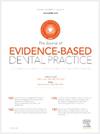ORAL HEALTH IMPACT OF DENTAL HYGIENE AND DENTAL THERAPY PATIENT POPULATIONS—AN EVIDENCE UPDATE IN 2024
IF 4
4区 医学
Q1 DENTISTRY, ORAL SURGERY & MEDICINE
引用次数: 0
Abstract
Objectives
Dental patient-reported outcomes, especially the Oral Health-Related Quality of Life (OHRQoL) construct, are vital for evidence-based dentistry. This construct includes four dimensions (4D): Oral Function, Orofacial Pain, Orofacial Appearance, and Psychosocial Impact. This study updates previous work characterizing 4D OHRQoL impairment among patients in dental hygiene (DH) and dental therapy (DT) settings.
Methods
An expert panel revised previously determined DH and DT patient population groups to align them with current scopes of practice. An updated systematic review was then conducted to incorporate recent studies using the Oral Health Impact Profile (OHIP) to assess 4D OHRQoL in these populations. The search spanned 6 databases from January 1, 2023, to April 16, 2024.
Results
The panel identified 20 patient populations, representing the scope of DH and DT practice. The systematic review contained 19 studies (17 from the previous review and 2 new ones). Studies’ OHRQoL data covered only 30 % of dental hygiene and dental therapy patient populations identified by the panel. The most frequently studied group was “therapeutic periodontal treatment–patients with periodontitis” (n = 17, 89 %), followed by “oral hygiene instructions–all patients” (n = 13, 68 %). Only four studies provided 4D OHRQoL data, showing the greatest impacts in Orofacial Pain (baseline OHIP: 3.10-4.20; follow-up: 1.52-3.60) and Orofacial Appearance (baseline OHIP: 0.44-2.50; follow-up: 0.91-2.25). Among studies reporting summary OHIP scores only (n = 15), overall OHRQoL impairment ranged from 1.40 to 42.35 at baseline and 1.50-40.56 at follow-up. All studies demonstrated a general trend of reduced OHRQoL impairment over time with treatment. Risk of bias was low, with no evidence of publication bias.
Conclusion
Current evidence on OHRQoL impairment in DH and DT patient populations is limited, covering only a third of those treated by dental hygienists and therapists. Especially, scarce 4D OHRQoL data prompts the need for more research in this format. Despite these limitations, the findings show promising trends of reduced OHRQoL impairment over time for DH and DT patient populations.
口腔卫生和牙科治疗患者群体对口腔健康的影响——2024年证据更新
目的牙科患者报告的结果,特别是口腔健康相关生活质量(OHRQoL)结构,对循证牙科至关重要。该结构包括四个维度(4D):口腔功能、口腔面部疼痛、口腔面部外观和社会心理影响。这项研究更新了先前的工作,描述了牙科卫生(DH)和牙科治疗(DT)设置患者的4D OHRQoL损害。方法一个专家小组修订了先前确定的DH和DT患者群体,使其与当前的实践范围保持一致。然后进行了一项更新的系统评价,以纳入使用口腔健康影响概况(OHIP)的最新研究,以评估这些人群的4D OHRQoL。从2023年1月1日到2024年4月16日,搜索跨越了6个数据库。结果小组确定了20个患者群体,代表了DH和DT实践的范围。该系统综述包含19项研究(17项来自先前的综述,2项来自新综述)。研究的OHRQoL数据仅覆盖了专家组确定的30% %的牙科卫生和牙科治疗患者群体。最常见的研究组是“牙周治疗-牙周炎患者”( = 17,89 %),其次是“口腔卫生指导-所有患者”( = 13,68 %)。只有4项研究提供了4D OHRQoL数据,显示了对口腔面部疼痛的最大影响(基线OHIP: 3.10-4.20;随访:1.52-3.60)和口腔面部外观(基线OHIP: 0.44-2.50;追问:0.91 - -2.25)。在仅报告汇总OHIP评分的研究中(n = 15),总体OHRQoL损害在基线时为1.40 - 42.35,在随访时为1.50-40.56。所有的研究都表明,随着治疗时间的推移,OHRQoL损害的总体趋势减少。偏倚风险低,无发表偏倚证据。结论目前关于DH和DT患者OHRQoL受损的证据有限,仅覆盖了牙科保健师和治疗师治疗的三分之一。特别是由于缺乏4D OHRQoL数据,因此需要对这种格式进行更多的研究。尽管存在这些局限性,但研究结果显示,随着时间的推移,DH和DT患者群体的OHRQoL损害有所减少。
本文章由计算机程序翻译,如有差异,请以英文原文为准。
求助全文
约1分钟内获得全文
求助全文
来源期刊

Journal of Evidence-Based Dental Practice
DENTISTRY, ORAL SURGERY & MEDICINE-
CiteScore
6.00
自引率
16.70%
发文量
105
审稿时长
28 days
期刊介绍:
The Journal of Evidence-Based Dental Practice presents timely original articles, as well as reviews of articles on the results and outcomes of clinical procedures and treatment. The Journal advocates the use or rejection of a procedure based on solid, clinical evidence found in literature. The Journal''s dynamic operating principles are explicitness in process and objectives, publication of the highest-quality reviews and original articles, and an emphasis on objectivity.
 求助内容:
求助内容: 应助结果提醒方式:
应助结果提醒方式:


